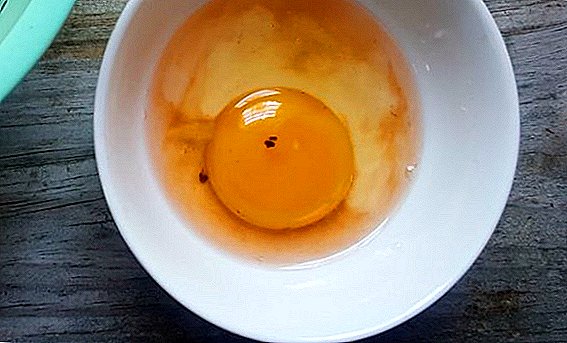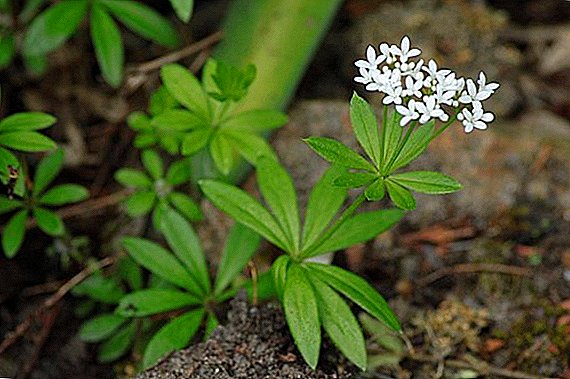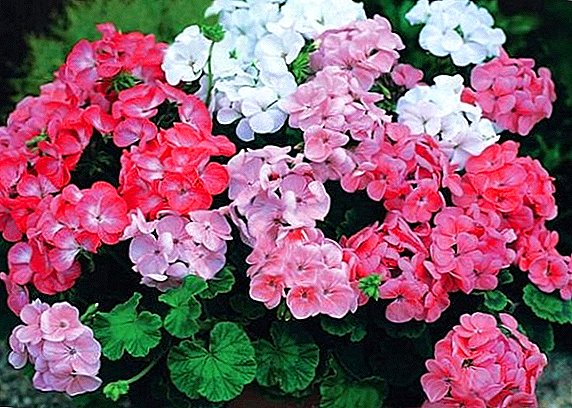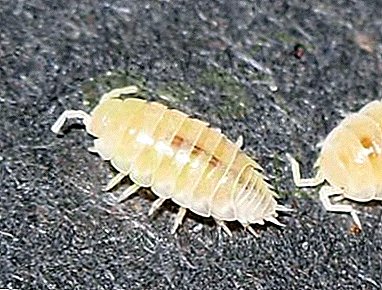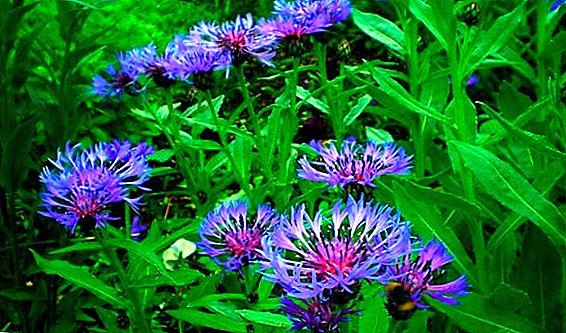 Microscopic fungus Alternaria is divided into many species. But today we will look at two specific types that can trigger a serious illness - alternarioz on grape plantations or in the summer cottage.
Microscopic fungus Alternaria is divided into many species. But today we will look at two specific types that can trigger a serious illness - alternarioz on grape plantations or in the summer cottage.
Description and Symptoms
In the last decade, Alternaria only strengthened and became more resistant to external influence. The damage of grape crops, which are characterized by the influence on the vegetative mass and yield, is monitored everywhere.
Did you know? Just 17 years ago, fungi that cause Alternaria, were not yet considered to be the ones that first hit the plant, it was believed that they colonize crops after their death or damage by other diseases.

Vineyards may be affected:
- Alternaria alternate which in turn provokes the development of Uni Blanc disease. The disease begins to manifest itself at the end of the spring period, when on the grape foliage one can find yellowish spotting of small sizes, up to one centimeter. If you tear one affected leaf and look through it into the light, you can see the spotting more pronounced. In the period of rains and dampness in the lower part of the sheets can be considered the formation of olive moldy plaque. If this happens, then the edges of the affected leaf shrink, it becomes gray and looks burnt. The same plaque can be formed not only on the leafy part of the plant, but also on the berries and crests. At the end of the summer period, when the maturation of the woody part of the plant occurs, other symptoms of the disease can be traced. Aging of green shoots occurs in an uneven manner: some of them remain green for a long time, and then simply become whitish, instead of browning. In winter, the bark lightens, it acquires an off-white shade and staining occurs. Also, a characteristic feature of this disease is reduced winter hardiness of the plant, and when planting new seedlings there is a problem with their rooting - they massively perish.
Did you know? In 2000, scientists were able to detect Alternaria, which was the first to inhabit fruit trees, and from that time, active opposition from science began to prevent or cure the disease of plants that Alternaria fungi cause.

- Alternaire tenussima - a disease of grapes, which until recently was considered harmless, as scientists were convinced that it affects only the already dead or wounded plant, as well as grapes, which has a weakened immune system. But as it turned out, the disease quite independently can cause severe damage to vineyards and affect healthy and strong plants. There is a massive infection of European-American hybrids, which have a low rate of treatment with chemicals, as they are resistant to other dangerous diseases. Going on damage to the green part of the plant - leaves, shoots, ridges. This disease manifests itself already in the formation of the first foliage, when they can observe the formation of a rim from the shrunken part of the leaflet, which can be confused with a sign of potassium deficiency. When the air temperature exceeds the limits of + 26 ° C, and a sufficiently high humidity is observed, then the total death of the kidneys and significant damage to the shoots can occur. When a lot of leaves have already formed on the shoots, the disease manifests itself as a massive defeat of the green mass with brown fine spot. Alternaria can provoke drying of leaves and shoots of grapes, when there is no resistance to the disease in the form of chemical processing. If Alternariosis is accompanied by increased humidity and high air temperature, the disease can spread particularly quickly through the plant and it will dry out at lightning speed - in 4-5 days. Alternariosis often parasitizes in tandem with Fomopsis, which greatly aggravates the condition of the grapes and complicates the fight against disease. Alternaria is especially active throughout the plant in the spring, and when the air warms up to 30 ° C, the grapes can completely lose the leaves, but the fungus does not die, but continues to parasitize the entire vegetation period.
Check out the most popular grape varieties: "Original", "Jupiter", "Veles", "Bazhena", "Annie", "Delight", "Laura", "Victoria", "Timur", "Arcadia", "Amur" , "Libya", "Lily of the Valley" and "Chameleon".

Causes and pathogen
As indicated above, Alternaria is a fungal disease that can affect the entire ground portion of grapes. Due to such optional parasites as Alternaria alternate and Alternaria tenussima, weakened plants are colonized. The development of the fungus is triggered by high air temperature and humidity. Over the past 10 years, the disease has become particularly resistant to weather changes and has spread to different vineyards, while the severity of alternariosis has increased.
Treatment of Alternaria
When the plant was defeated, it is necessary to fight to start treatment so as not to aggravate the situation and stop the spread of the fungus to other plants. Consider how and what to treat Alternaria grapes, to get the highest quality result and stop the parasitism of the fungus.  There are many treatments that are in their own way good and effective. Among them are the popular methods and methods of treatment with the help of chemicals.
There are many treatments that are in their own way good and effective. Among them are the popular methods and methods of treatment with the help of chemicals.
Folk methods
Folk methods more effective in preventive purposes, rather than curative, but they are also often used in order to reduce the parasitic effect of the fungus on plants in combination with chemical processing.
Korovyak in the form of infusion. This tool is prepared at home, it is necessary to use 3 kg of manure per 10 liters of water. Infuse the mixture for 3 days, then pass through the filter and apply to spray the ground part of the plant. This tool is very popular among growers, as it does not contain harmful substances and is safe for people and plants. 
Potassium permanganate To prepare the solution, use 5 g of product per 11 l of water. It is necessary to pay special attention to the preparation of the solution in order to prevent severe burns in the plant.
Important! If you notice that the solution is very dark (in a properly prepared solution a light pink shade of the liquid will be traced), then it should be further diluted with water.After preparation, the ground part of the affected plants should be sprayed.

Milk. For cooking means you need to use 1 part of milk and 10 parts of water. The resulting liquid is processing the ground part of the plant. Due to the influence of sunlight and high air temperature, the active development of lactic acid bacteria will occur, which will help to suppress the growth of the fungus that causes Alternaria. 
Laundry soap with soda ash. For the preparation of this tool should be used 30 g of soda and 30 g of soap per 10 liters of water. Due to the characteristic film that is formed after applying the product to the plant, the fungus will not be able to overcome the barrier and will suffer from the alkaline effects of soda. 
Chemicals
In order to get rid of Alternaria grapes, it is most effective to treat the plant with chemical agents.
It is definitely necessary to begin treatment when you find clear signs of Alternaria, which will mean the disease is flowing into a severe form.
Well help in this case processing Bordeaux mixture. For the treatment to be effective and not to harm the plant, it is necessary to take a responsible approach to the preparation of the mixture.
Find out what other diseases the grapes suffer: oidium, anthracnose, chlorosis and mildew.

It will be correct to prepare a mix, observing the rules:
- Breeding of copper sulphate and lime should be done in different vessels.
- The mixture of lime and water is thoroughly mixed and filtered.
- The solution of copper sulfate should be filtered and a little lime is added.
Important! It is possible to check whether you diluted the vitriol with lime by combining liquids in small quantities together. If the mixture does not curdle during the manipulation, then everything is done correctly and large portions can be mixed.

Processing can be performed regardless of the stages of the growing season. Usually made up to 6 treatments per season. After processing, you can begin to eat fruits after 20 days after processing.
Very effective and popular means for processing grapes is considered "Trichodermin". It is necessary to prepare means for use according to the instruction on packaging. Treat this tool is necessary during the period when the first opening of the leaves of the vine. It is important to take into account the air temperature during the treatment period, it should not be below 15 ° C.
After treatment with Trichodermine, you can resort to the use of other chemical preparations, which are sprayed with vineyards with an interval of 2 weeks between different treatments.
Effective means that can be used in the fight against Alternaria, are: "Skor", "Kvadris", "Rapid Gold". 
Prevention
In order to avoid infection of grapes with Alternaria, it is necessary:
- timely remove organic residues;
- spray with a solution of Bordeaux mixture of 2%;
- to feed regularly with mineral fertilizers that will enhance immunity;
- observe the proper agricultural practices on vineyards.
Resistant varieties
In order to avoid infection with Alternaria, grapes are recommended to acquire varieties that are resistant to the disease. At the moment, specially bred varieties that are able to resist these fungi does not exist. But given that Alternaria is very similar to other diseases, such as black rot and altracnosis, it is advised to choose grapes that are well opposed to these diseases. You can resort to planting:
- "Traminer";
- Cabernet Sauvignon;
- "Rkatsiteli";
- "Riesling".
 At the moment there are no data on the manifestations of Alternaria on:
At the moment there are no data on the manifestations of Alternaria on:- "Amur breakthrough";
- "Amur Triumph";
- "Amethyst";
- "Marinovsky".




